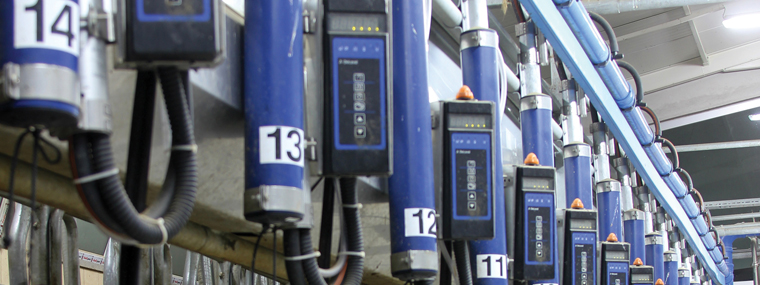
Entering the Dairy Market
It’s Worth A Serious Look
By Diane M. Calabrese /Published October 2017

C
leaning Diaries
Cows and milk have both fallen from favor in the last decade. It’s a bit sad, but it’s reality. The methane cows produce through their digestive process alarms those monitoring emissions of gasses that enter the atmosphere. Milk fat concerns those striving for a healthy diet.
Forget that generations grew to adulthood as they drank milk every day. Things have changed. ‘Baby-friendly’ hospital nurseries forbid any milk except that from lactating mothers.
In the marketplace, beverages made from almonds, soy, rice, and coconut compete with milk. Some liquid alternatives address serious issues such as lactose intolerance.
According to an article published in the August 10, 2017, issue of The Wall Street Journal (“Milk Firms Move to Fix Sour Sales” by Mike Cherney and Heather Haddon), dairy farmers hope to use genetic tests to select for milk cows that produce more easily digestible milk. That might increase sales. Experts quoted say it will not be easy to do so, though.
How then go the opportunities for cleaning dairies? They can be found, but there are caveats.
Three members of our industry who talked with us on background for this story offer points that sum up the outlook on cleaning dairies. One notes that even in an area long tied to dairy farming, “nonexistent” is the best way to characterize dairies in the region now. Another says that almost all cleaning is done with CIP (clean-in-place) equipment, except for the exterior of buildings, which is done with water and hoses (and perhaps pressure washers). Finally, a third tells us that for distributors doing equipment sales other than customized CIP systems, there are still opportunities to supply equipment to dairies to clean their tractors and trucks.
There’s also a brighter spot to consider. Everything in and around dairies, including the cows, must be cleaned. Sanitation is of utmost importance in any facility that produces milk and related dairy products. Not surprisingly, semi-automated systems to clean cows before they enter the milking parlor are now in the mix. Artificial intelligence systems are gaining ground, too.
For instance, in an April 24, 2013, press release announcing its steam pressure washer, the Super Max 15200, Daimer Industries Inc. in Woburn, MA, cites the utility of the machine to the dairy industry. As the press release notes, there are “an almost unending list of surfaces and machinery that must be cleaned in dairy settings”— something to consider before writing off the possibility of cleaning dairies.
Everything from totes to troughs, as well as the trucks and tractors, must be cleaned. CIP is the method used for cleaning almost any surface that comes in contact with milk or a milk product during processing, but beyond the processing surfaces, there are plenty of junctures where a contract cleaner or a distributor of cleaning equipment might find a niche.
Scope
In 2013, the National Agricultural Statistics Service (NASS) of the U.S. Department of Agriculture (USDA) reported a 33 percent decrease in milk cow operations over the 10-year period 2003–2012. The decline in the number of operations, however, did not lead to a decrease in milk production. According to the NASS, milk production increased by 14 percent between 2007 and 2016. A NASS report issued in February 2017 put 2016 production of milk close to 215,000 million pounds.
Many dairy-related organizations provide data on the number of cows, farms, and dairies. The Dairy Farmers of America (DFA), headquartered in Kansas City, MO, unites 15,000 dairy farmers. It is also an owner of 33 diverse manufacturing plants, which produce fluid milk and ice cream, butter and cheese, and ingredient cheese.
 Today, there are approximately 42,000 dairy farms in the United States, and more than 95 percent of them are family-owned and operated. As for dairy cows, there are some 9.31 million. Milk production of cows varies by region. In the Midwest, it ranges by state average from about four gallons per cow to seven gallons per cow.
Today, there are approximately 42,000 dairy farms in the United States, and more than 95 percent of them are family-owned and operated. As for dairy cows, there are some 9.31 million. Milk production of cows varies by region. In the Midwest, it ranges by state average from about four gallons per cow to seven gallons per cow.
Products sold from U.S. dairy farms contribute significantly to the economy, adding about $36 billion. Dairy farms also bolster U.S. employment, accounting for some 900,000 jobs.
Dairy exports are also important to the U.S. economy. According to the U.S. Dairy Export Council (USDEC), about $4.9 billion of dairy products are now exported. As many as 100,000 jobs are tied to dairy exports. And the economic impact from dairy exports is $14.6 billion.
As for dairy plants—both exporting and non-exporting—the USDEC puts the number at 1,267. For the contract cleaner or equipment distributor who has not considered entering the dairy market, it’s at least worth a serious look.
Some states have more activity in the dairy products niche. There is a great deal of variation on the national scale, even among states in a particular region. Take a sampling from states in the Midwest. Minnesota is the seventh largest milk-producing state. Iowa ranks at 12, and Kansas at 19.
Environmental concerns transcend industries. Sustainable use of energy and adherence to local, state, and federal regulations governing clean water are of as much interest to the dairy industry as any other. The DFA regularly notes the successes of its dairies in achieving both goals. Re-circulating water enabled one Golden State dairy plant to reduce well water use by 120,000 gallons each month.
Similarly, upgrades to a plant in Missouri resulted in reduction in use of water, electricity, and natural gas. The improvements included repairs to steam trap, new boiler and reclamation of glass rinse water.
And, in Colorado, a plant cut water and electricity use by collecting water from milk concentration and recycling it to use for cleaning. The process saves two million gallons of water each year.
Wastewater treatment plants are a huge concern to DFA members. Manufacturers and distributors in our industry that can provide dairies with solutions for wastewater treatment will find a market opening.
Method
Sanitary. That’s the operative word for working in and around dairy plants. Dairy facilities tap methods for cleaning that reduce the need for manual intervention, especially disassembling to clean. CIP methods allow both detergents and sanitizers to move through equipment. The action of detergents may be enhanced by agitation, pressure, heat, or steam.
The Environmental Protection Agency (EPA) not only prescribes which chemicals (detergents) can be used
but also monitors how wastewater is being discarded. Plants must operate within all parameters of and with all permits required under the National Pollution Discharge Elimination System (NPDES), which is an outgrowth of the Clean Water Act of 1987.
There are many good introductions to cleaning in dairy plants. One is the Dairy Processing Handbook. Take a look at a sample from the chapter on cleaning equipment via dairyprocessinghandbook.com/chapter/cleaning-dairy-equipment.
An excellent reference available at no cost from PennState Extension stands as a good overview of cleaning expectations in dairies. The reference also includes cards that can be printed and used for training employees on steps in cleaning and sanitizing. See “Key Concepts of Cleaning and Sanitizing” by Kerry E. Kaylegian, Ph.D., via the link extension.psu.edu/food/dairy/sanitation-controls/key-concepts.
The PennState Extension text provides a dairy perspective on a distinction that’s quite familiar to members of our industry—the difference between cleaning and sanitizing. The former removes the dirt; the latter cuts down on microbes. (Sanitizing is not sterilizing, and it is sterilizing that achieves—at least for a brief instant in time—the elimination of most microbes.)
From there, the text covers everything that must be cleaned. All food contact surfaces are on the list. Think broadly from equipment to conveyors to bins to packaging materials. Floors, drains, walls, and light fixtures are on the list, too.
What’s very useful about the text to those who have not worked in dairy plants is the review of the types of soils that must be cleaned from surfaces. Soiling agents include the carbohydrates, proteins, fat (fatty acids), and minerals (e.g., calcium, phosphorous, magnesium) from milk. The microorganisms that must be thwarted can originate anywhere in the environment of the dairy plant, including from the milk itself.
Another particularly welcome part of the text is an emphasis on precautions required to avoid cross contamination. Buckets for manual cleaning should be clean. Brushes should be used only on one type of surface, especially if it’s something like a drain. Manufacturers’ instructions should be followed when cleaning equipment. It’s good advice that applies beyond dairy plants, as are the reminders about PPE and personal hygiene.
Tainted food products cause marketplace and legal trouble for manufacturers and distributors. Dairies and other food processing facilities take every measure possible to move out products that are safe to consumers. They welcome assistance from contractors, distributors, and manufacturers who understand their industry.
Get started in learning more about cleaning processes (and opportunities) in dairy plants by reviewing the instructional offerings (online text and videos) of agricultural extension agents in county, state, and university positions in the geographic area of interest.





